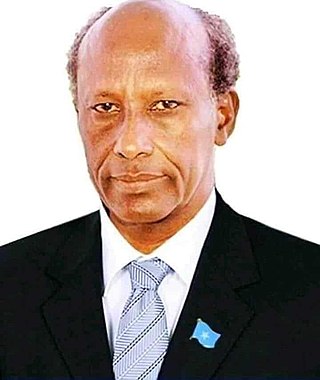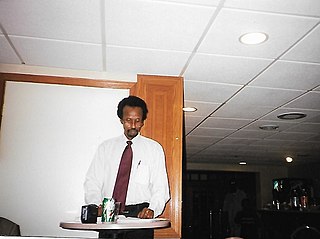
The Ethiopian National Defense Force (ENDF) is the combined military force of Ethiopia. ENDF is consisted of 10 command forces which is controlled by the Chief of General Staff.

The Somali Armed Forces are the military forces of the Federal Republic of Somalia. Headed by the president as commander-in-chief, they are constitutionally mandated to ensure the nation's sovereignty, independence and territorial integrity.

Mohamed Farrah Hasan Garad, popularly known as General Aidid or Aideed, was a Somali military officer and warlord.

Ogaden is one of the historical names used for the modern Somali Region. It is also natively referred to as Soomaali Galbeed. The region forms the eastern portion of Ethiopia and borders Somalia. It also includes another region to the north known as Haud.

The Ogaden War, also known as the Ethio-Somali War, was a military conflict fought between Somalia and Ethiopia from July 1977 to March 1978 over the sovereignty of Ogaden. Somalia's invasion of the region, precursor to the wider war, met with the Soviet Union's disapproval, leading the superpower to end its support for Somalia and to fully support Ethiopia instead.

The Ogaden National Liberation Front, Abbreviated ONLF; Somali: Jabhadda Waddaniga Xoreynta Ogaadeeniya, Abbrieviated JAWXO; Arabic: الجبهة الوطنية لتحرير أوجادين, romanized: Al-Jabhat al-wataniat litahrir 'Awjadin, Abbreviated ALJAWLA, is a Somali politico-military organization which aims for the right to Self-determination of the Somali People in the Ogaden or the Somali Region under the control of Ethiopia.

Mohammad Ali Samatar. was a Somali military officer, politician, former Commander-in-Chief of the Somali National Army, former Minister of Defence, former Vice President (1971-1990), former Deputy General Secretary of the Somali Revolutionary Socialist Party, and former Prime Minister. He was known for his intelligent military tactics in the 1964 Ethiopian–Somali Border War, Ogaden War and 1982 Ethiopian–Somali Border War.

The Ogaden is one of the major Somali clans in the Horn of Africa.

Al-Itihaad al-Islamiya was an Islamist politico-military group in Somalia. Formed in 1983 through a merger of smaller Islamist groups, the organization was the most powerful Islamic movement in the country during the late 80s and early 90s. It also had the most widespread clan following of all the Islamist factions across the nation and professed the aim of creating a Somali Islamic state.

The Ethiopian–Somali conflict is a territorial and political dispute between Ethiopia, Somalia, and insurgents in the area.

The Somaliland Campaign, also called the Anglo-Somali War or the Dervish War, was a series of military expeditions that took place between 1900 and 1920 in modern-day Somalia. The British were assisted in their offensives by the Ethiopian Empire and the Kingdom of Italy.

The 2007–2008 Ethiopian crackdown in Ogaden was a military campaign by the Ethiopian Army against the Ogaden National Liberation Front (ONLF). The crackdown against the guerrillas began after they killed over 60 Ethiopian troops and several foreign workers during a raid on a Chinese-run oil exploration field in April 2007.

The Insurgency in Ogaden was an armed conflict that took place from 1992 to 2018. It was waged by nationalist and islamist Somali insurgent groups seeking self determination for the region, primarily the Ogaden National Liberation Front (ONLF) and Al-Itihaad Al-Islamiya (AIAI). The war in the region began in 1992, when the Ethiopian government attacked AIAI in an attempt to suppress the growth of the organization. In 1994, the ONLF commenced its armed struggle and began publicly calling for an independent 'Ogadenia' state.
Mustahīl is a town in eastern Ethiopia, close to the border with Somalia. Located in the Gode Zone in the Somali Region and straddling the Shabelle River, it has a latitude and longitude of 5°15′N44°44′E with an altitude of 193 meters above sea level. It is the main town of the Mustahīl woreda. This district belongs to Jidle tribe

The military history of Somalia encompasses the major conventional wars, conflicts and skirmishes involving the historic empires, kingdoms and sultanates in the territory of present-day Somalia, through to modern times. It also covers the martial traditions, military architecture and hardware employed by Somali armies and their opponents.

Abdullahi Ahmed Irro, also known as Abdullahi Ahmed Yusuf Irro, was a prominent Somali military professor and general. He helped establish the National Academy for Strategy.

Dr. Mohamed Sirad Dolal was an academic and a member of the central committee and executive council of the Ogaden National Liberation Front (ONLF), a liberation movement in Ogaden determined to free its homeland from Ethiopia.

The Order of the Somali Star is the highest distinction award for military gallantry in Somalia. The Order of the Somali Star has been awarded to members of the Somali Armed Forces and foreign citizens who have conducted and exhibited great fidelity to the Somali Republic. It has been issued mainly during the Ogaden War to military and police officers posthumously.
The 1995 Ethiopian Federal Constitution formalizes an ethnic federalism law aimed at undermining long-standing ethnic imperial rule, reducing ethnic tensions, promoting regional autonomy, and upholding unqualified rights to self-determination and secession in a state with more than 80 different ethnic groups. But the constitution is divisive, both among Ethiopian nationalists who believe it undermines centralized authority and fuels interethnic conflict, and among ethnic federalists who fear that the development of its vague components could lead to authoritarian centralization or even the maintenance of minority ethnic hegemony. Parliamentary elections since 1995 have taken place every five years since enactment. All but one of these have resulted in government by members of the Ethiopian People's Revolutionary Democratic Front (EPRDF) political coalition, under three prime ministers. The EPRDF was under the effective control of the Tigray People's Liberation Front (TPLF), which represents a small ethnic minority. In 2019 the EPRDF, under Abiy, was dissolved and he inaugurated the pan-ethnic Prosperity Party which won the 2021 Ethiopian Election, returning him as prime minister. But both political entities were different kinds of responses to the ongoing tension between constitutional ethnic federalism and the Ethiopian state's authority. Over the same period, and all administrations, a range of major conflicts with ethnic roots have occurred or continued, and the press and availability of information have been controlled. There has also been dramatic economic growth and liberalization, which has itself been attributed to, and used to justify, authoritarian state policy.

On 20 July 2022, the Islamist militant group al-Shabaab launched an invasion from Somalia into Ethiopia's Somali Region. Taking advantage of the instability created by the Tigray war, the goal of the operation was to establish a presence for the group within southern Ethiopia.



















